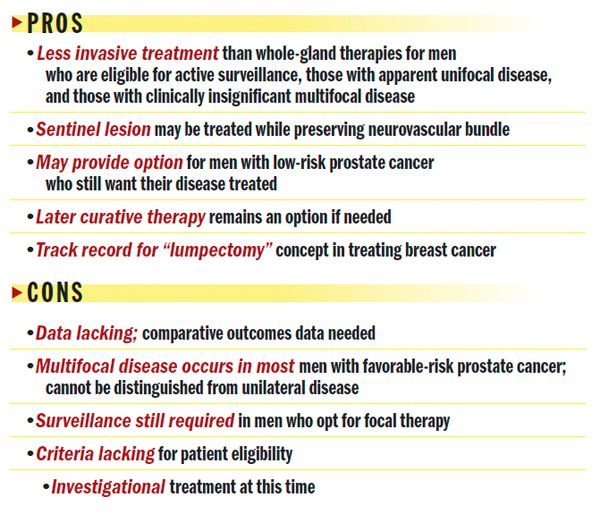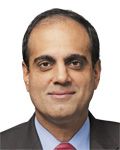Article
Focal therapy: Magic bullet or unproven treatment?
Author(s):
Focal therapy has been promoted as a minimally morbid option for men with localized low-risk prostate cancer who nevertheless want their disease treated. Opponents of focal therapy note the heterogeneity and multifocal nature of prostate cancer, the difficulty of accurately targeting and destroying an index tumor with focal therapy, and the unknown biologic potential of the tumor.
National Report-Focal therapy has been promoted as a minimally morbid option for men with localized low-risk prostate cancer who nevertheless want their disease treated. Opponents of focal therapy note the heterogeneity and multifocal nature of prostate cancer, the difficulty of accurately targeting and destroying an index tumor with focal therapy, and the unknown biologic potential of the tumor.

Even advocates admit the substantial uncertainty with regard to survival and the lack of comparative data from which to draw meaningful conclusions.
Despite the uncertainty, “I think there is a big future [for focal therapy], and I believe frankly that, in combination with imaging and image-guided biopsy, it will transform our thinking about prostate cancer and the way we treat it,” said Samir S. Taneja, MD, director of the division of urologic oncology at New York University Langone Medical Center, New York.
Similar to breast lumpectomy
Focal therapy refers to a broad range of treatments designed to identify and ablate only the malignant portions of the prostate, sparing noncancerous tissue (or tissue with small, low-grade tumors considered clinically insignificant) in an effort to preserve quality of life.

Dr. Eggener“It’s very similar conceptually to lumpectomy [for breast cancer],” said Scott Eggener, MD, associate professor of surgery and co-director of the prostate cancer program at the University of Chicago. “Nowadays, 80% of women have just the area of breast cancer removed.”
Whole-gland therapies such as radical prostatectomy and radiation are considered definitive treatments but carry a significant quality of life burden including incontinence, erectile dysfunction, and decreased bowel function. Active surveillance is the least aggressive approach, but concern exists over missing the window of opportunity for treatment.
Continue to next page for more.
“If surgery or radiation therapy had negligible potential side effects, there would be no need for active surveillance or focal therapy,” Dr. Eggener said.

Dr. ThrasherThe genesis of focal therapy is the belief that prostate cancer has been overtreated, the desire for less invasive treatments, the improvements in imaging technology, and the ability to treat the sentinel lesion while preserving the neurovascular bundle, said J. Brantley Thrasher, MD, chair of the department of urology at the University of Kansas Medical Center, Kansas City. “All of these appear to be the drivers.”
The rationale is that the index lesion drives the natural history of prostate cancer, and targeting it specifically will control the malignant potential of the disease without the need for more aggressive and morbid treatment. Focal therapy would not preclude later use of curative therapy if needed, its supporters argue.
“Those that believe in focal therapy, myself included, would argue that most metastases arise from a dominant focus of disease within the gland, and if you can find effective ways to identify that focus, then we would be effective in removing the lethality of the disease or the potential lethality of the disease,” Dr. Taneja said.
Energy sources used for focal therapy include cryoablation, high-intensity focused ultrasound, photodynamic therapy, electroporation, radiofrequency, bipolar radiofrequency, lasers, and radiation (either external or seed implant).
“Each has relative merits, and while all have been tried for focal therapy, in or out of clinical trials, none are approved by the U.S. Food and Drug Administration specifically for focal therapy,” Dr. Taneja pointed out.
No uniform eligibility criteria
No uniformly accepted eligibility criteria for focal therapy exist, Dr. Eggener notes, resulting in dissent over its application, and a percentage of urologists believe strongly that it should never be done. The “never” camp cites the lack of outcomes data with focal therapy and contends that most men with even favorable-risk prostate cancer have multifocal disease that can’t be distinguished from unilateral disease beforehand. Also, no agreed definition of clinically significant disease exists, to the point that consensus is lacking over inclusion criteria for any clinical trials that may test focal therapy.
“We know that if you cross section prostates that have been removed for what we thought was clinically localized cancer, the average prostate has between 3 and 5 cancers in it in various stages of evolution,” Dr. Thrasher said. “There’s always a concern that our imaging studies aren’t quite accurate enough for us to be able to identify all of those lesions. If I treated what I thought was the sentinel lesion, is it possible that I could then miss tumors that are potentially lethal?”
Among those who support focal therapy, candidates include men who are eligible for active surveillance, men with apparent unifocal disease, and men with clinically insignificant multifocal disease.
Focal therapy requires a retraining of the physician and a retraining of the patient to recognize that “if you’re going to treat somebody with focal therapy, you are very likely leaving tiny amounts of indolent disease somewhere in that gland,” Dr. Taneja said. “That’s not much different from doing a lumpectomy on a woman with breast cancer.”
“Most of the advocates of focal therapy would argue that even if a man has a small amount of Gleason 6 prostate cancer in other areas of his prostate that aren’t treated, it’s highly unlikely that those small areas of Gleason 6 will become clinically meaningful, and they’re followed anyway after focal therapy,” Dr. Eggener said.
“In my program, a good candidate is a patient with Gleason 3+3 or 3+4 disease, limited volume and focality, and concordance of biopsy and MRI,” said Dr. Taneja. “These are men that most of us would not feel comfortable putting on a surveillance protocol. We don’t want to use focal therapy as an excuse to treat men who don’t need it.”
Continue to next page for more.
The role of biopsy or image guidance
Accurately detecting and mapping prostate cancers within the gland is a challenge to applying focal therapy, which can be guided by biopsy or by imaging. Advances in imaging technologies and biopsy techniques are improving the preoperative estimates of pathology.

Dr. TanejaIn the case of biopsy guidance, the method of sampling influences the amount of tissue to be destroyed, says Dr. Taneja.
“For example, we know that a 12-core biopsy is very unlikely to accurately map the disease when applied alone,” he said. “A man with cancer on one side of the prostate would have a 75% likelihood of harboring cancer on the other side which was not detected by the biopsy.”
A biopsy that demonstrates disease on one side alone would require destruction of the entire lobe, because the exact location of disease is not demonstrated.
“A transperineal template biopsy, which employs 50 to 100 cores through the perineum, provides a better map of disease, allowing more precise destruction of only the region containing cancer,” said Dr. Taneja.
The cost, morbidity, and potential infection associated with saturation biopsy are drawbacks, but imaging alone risks missing small amounts of disease that may be below the threshold of detection, Dr. Taneja believes.
“In my program, I now utilize a combination of computerized template biopsy, MRI-ultrasound fusion biopsy, and MRI to guide the treatment plan,” he said. “Men who have concordant findings on MRI and biopsy are eligible for consideration.
“There are still those people who feel that the only way to include patients for focal therapy is to do a very intense saturation biopsy, map the disease completely, and treat every bit of disease that you know about.”
No comparative research
Dr. Taneja discusses focal therapy with his patients as an investigational approach, noting that the limited data so far show that it is safe, achieves control of the targeted tumor, and preserves potency. The impact on survival has not yet been determined. It also remains to be determined whether men treated by focal therapy have better quality of life than men on active surveillance, and whether focal therapy is less costly. Men who undergo focal therapy still require surveillance, although they may not need as many biopsies.
Doing comparative research in prostate cancer is difficult because patients usually have preconceived notions about the type of management strategy they want, says Dr. Thrasher.
“We’re challenged in that we’re having a hard time completing some of the clinical trials until you get into more advanced stages,” he said. “It’s my opinion that we won’t have a randomized trial that would compare focal therapy to one of the standards such as radiation or surgery.”
Accrual is almost complete in a National Cancer Institute-funded phase II trial of MRI-guided laser ablation as focal therapy being conducted by Dr. Eggener and Aytekin Oto, MD, at the University of Chicago. The phase I trial that preceded it demonstrated that MRI-guided laser ablation was safe.
“As someone who believes in focal therapy, I remain very concerned that there’s too much of an opportunity to mark this as a magic bullet before its time, and then it will fizzle out because we're going to have disasters,” said Dr. Taneja.
“I think there are already people in the community who are heavily marketing focal therapy as a standardized treatment option, and people are paying cash for it,” he added. “I just think that's very dangerous for the field and for medicine in general. This is a very provocative paradigm, but we also know that we’re still not very good in knowing exactly where the cancer is, what its extent is, who exactly is the right man for the treatment, and how to monitor effectiveness in the follow-up.”UT
Continue to next page for links to other recent Urology Times articles.
Like this article? Check out these other recent Urology Times articles:
New prostate cancer tests mark era of personalized medicine
Robotic vs. open RP: Equivocal results (again)
RT, hormonal combo treatment reduces prostate cancer mortality
Subscribe to Urology Times to get monthly news from the leading news source for urologists.

















